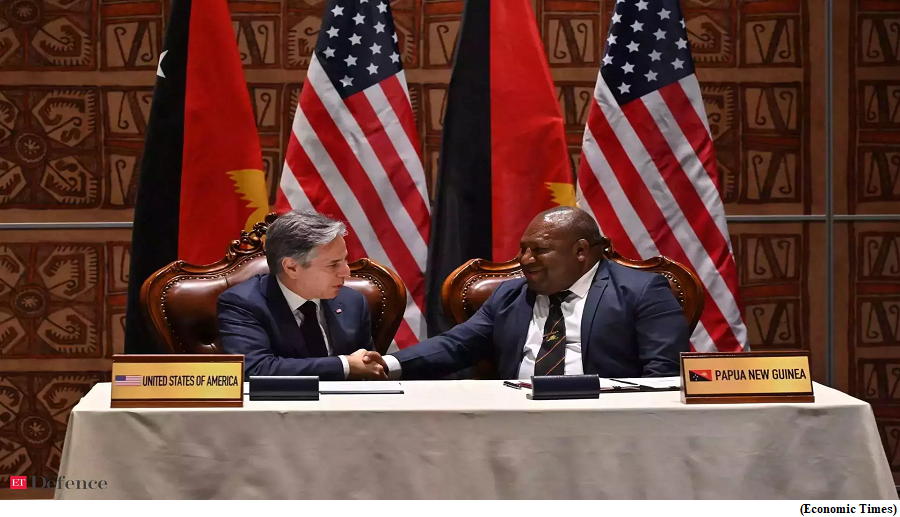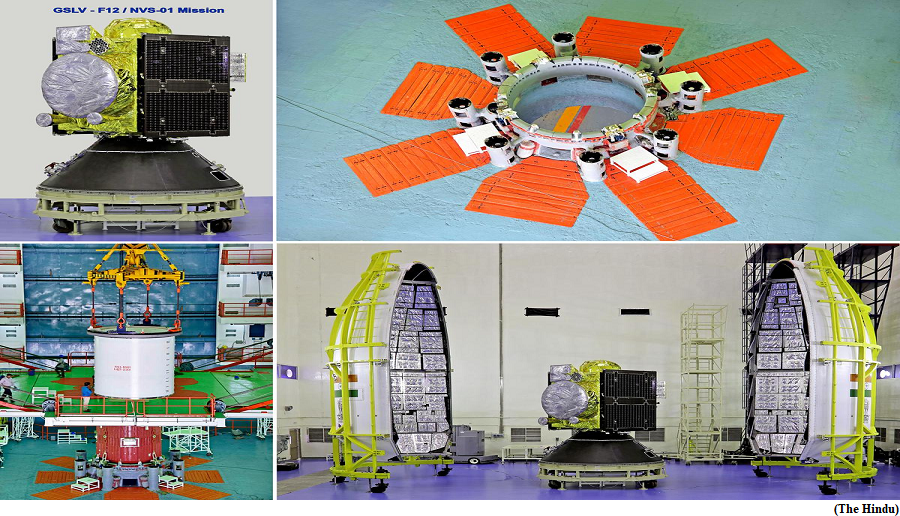U.S., Papua New Guinea sign defence pact at Pacific summit (GS Paper 2, International Relation)

Why in news?
- Recently, the U.S. signed a new security pact with Papua New Guinea on Monday as it competes with China for influence in the Pacific.
Why Papua New Guinea?
- Papua New Guinea’s location just north of Australia makes it strategically significant.
- It was the site of fierce battles during World War II, and with a population of nearly 10 million people, it’s the most populous Pacific Island nation.
Key Highlights:
- The new agreement provides a framework to help improve security cooperation, enhance the capacity of Papua New Guinea’s defence force and increase regional stability.
- The United States and PNG struck a separate agreement on increasing maritime surveillance of PNG’s exclusive economic zone through U.S. Coast Guard patrols, protecting its economy from illegal fishing.
- The United States will provide $45 million in new funds as it works with PNG to strengthen economic and security cooperation, including protective equipment for the PNG defence force, climate change mitigation and tackling transnational crime and HIV/AIDS.
- It will expand PNG defence capacity to enhance humanitarian assistance and disaster response, and make it easy for U.S. and PNG forces to train together.
China factor:
- U.S. Secretary of State Antony and Indian Prime Minister held separate summits with 14 Pacific island leaders in the PNG capital Port Moresby, pledging support for the region’s priorities of health, development and climate change.
- The United States and its allies are seeking to deter Pacific island nations from forming security ties with China, a rising concern amid tension over Taiwan, and after China signed a security pact with Solomon Islands.
- Leaders of the Pacific islands, whose territories span 40 million square km (15 million square miles) of ocean, have said rising sea levels caused by climate change are their most pressing security priority.
- The Quad leaders of Australia, United States, Japan and India had agreed in Hiroshima, Japan to increase cooperation with the Pacific.
Agreement with Palau:
- The United States also signed a Compact of Free Association with Palau, one of three agreements worth a combined $7.1 billion that will renew pacts originally struck in the 1980s with Palau, Marshall Islands and Federated States of Micronesia that give the U.S. defence responsibility and access to huge strategic swathes of the Pacific.
India US Working Group on Education and Skill Development virtually launched
(GS Paper 2, International Relation)
Why in news?
- Recently, the Ministry of Education, Government of India and US Department of State launched the India-US Working Group on Education and Skill Development in virtual mode, with the aim to enhance cooperation and collaboration between the two countries in the field of education and skill development.
- The establishment of the India-US Working Group on Education and Skill Development was announced by the leaders on the sidelines of the 2+2 Ministerial Dialogue held between India and US in Washington DC on 11th April 2022.

Key Highlights:
- Recognizing the need to align skills training programs with industry requirements, both sides agreed to foster partnerships between educational institutions, industry stakeholders, and relevant government agencies. This collaboration aims to address skills gaps, enhance employability, and promote entrepreneurship in both the countries.
- The delegations emphasized the significance of certification and recognition mechanisms in ensuring the quality and portability of skills across borders.
- Indian side explained the importance of mutual recognition of academic qualifications and skill certifications which is essential for smooth mobility of students and professionals between the two countries.
- Recognizing the potential for collaboration in the field of higher education, the delegations discussed the importance of matchmaking between higher educational institutions of India and US.
- The delegations agreed to encourage and facilitate such partnerships to foster academic and cultural exchange, enhance educational quality, and promote innovation and knowledge-sharing.
- Both sides agreed to encourage greater inter-linkages amongst the educational institutions. Indian side proposed that developing joint/dual and twinning courses in areas of mutual interest could be explored.
- Both sides acknowledged the importance of engagement with the private sector to align the education sector with the needs of the job market.
Way Forward:
- The delegations from both sides expressed their commitment to strengthening cooperation in education and skill development between India and US.
- The Joint Working Group agreed to continue regular meetings and explore concrete avenues to further advance education and skill development collaboration between India and US.
ISRO to launch new navigation satellite, NVS-01
(GS Paper 2, International Relation)
Why in news?
- The Indian Space Research Organisation (ISRO) will launch the NVS-01 navigation satellite, part of the Navigation with Indian Constellation (NavIC) series to space on May 29.

Details:
- The 2,232-kilogram satellite will lift off onboard India's workhorse, the Geosynchronous Satellite Launch Vehicle (GSLV) to space from the second launch pad at the Satish Dhawan Space Centre in Sriharikota.
- It will be deployed in the Geosynchronous Transfer Orbit.
- NVS-01 is the first of the second-generation satellites envisaged for the Navic constellation that is designed to sustain and augment the NavIC with enhanced features.
What is NavIC?
- The Global Positioning System (GPS) is a free service that is provided by a series of satellites in orbit maintained by the US government. NavIC is India's answer to the GPS.
- The Navigation with Indian Constellation (NavIC) is a regional navigation satellite system developed by ISRO that is a constellation of seven satellites in orbit that work in tandem with ground stations.
- The network provides navigational services to both general users and the strategic users, namely the armed forces.
- The seven satellites in the Navic constellation include IRNSS-1A, IRNSS-1B, IRNSS-1C, IRNSS-1D, IRNSS-1E, IRNSS-1F, and IRNSS-1G satellites.
Applications:
- The system was developed looking at the growing requirements of the Civil Aviation sector in the country for better positioning, navigation, and timing.
- The network covers an area including India and a region up to 1500 km beyond the Indian boundary. The signals are designed to provide user position accuracy better than 20 meters and timing accuracy better than 50 nanoseconds.
- The system is used in terrestrial, aerial, and marine transportation, location-based services, personal mobility, resource monitoring, surveying and geodesy, scientific research, time dissemination and synchronization, and safety-of-life alert dissemination.
- The NavIC system operates in the L5 band, which is a protected frequency specifically assigned to the Indian system. This dedicated frequency enhances the system's robustness and ensures minimal interference from other signals.
Way Forward:
- The NVS-1 being launched on May 29 incorporates L1 band signals additionally to widen the services.




